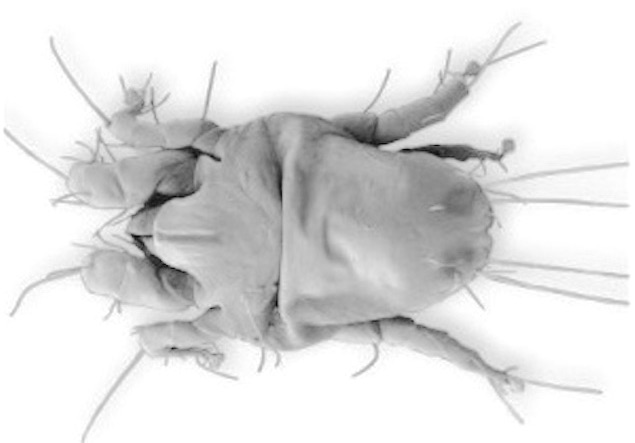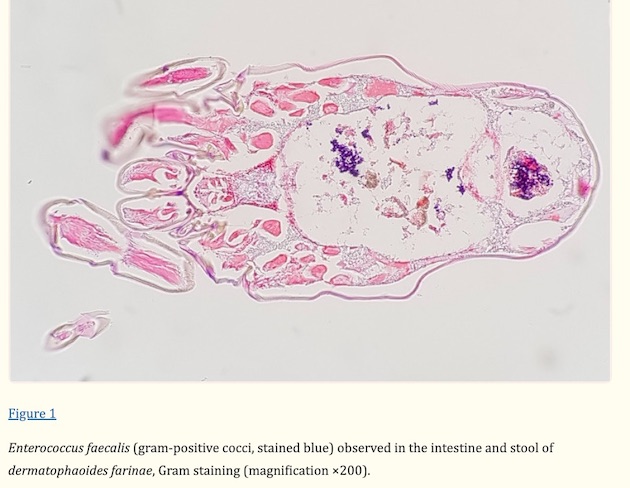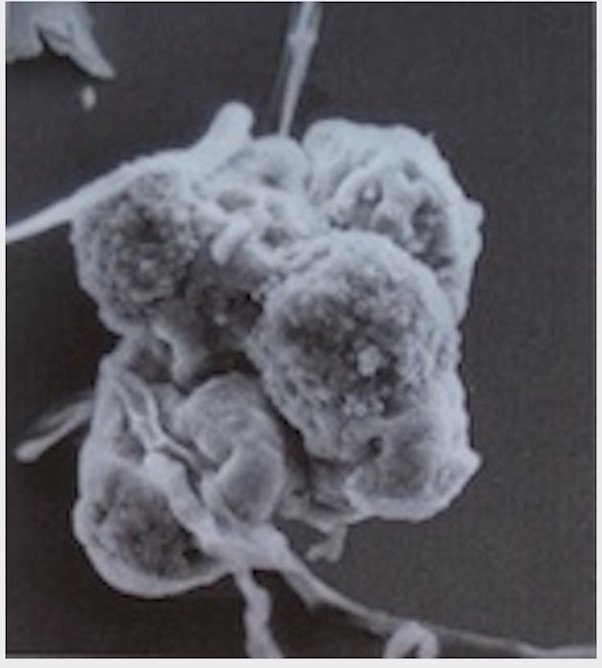House dust mite (HDM) droppings recycle bacteria and fungi
Life as a house dust mite is rich, varied and a reflection of its environment. As the mite is a prolific producer of food pellets or ‘droppings’ it is inevitable that they also contain other life mixed within the mite excrement. Each dropping can contain an array of digestive enzymes designed to break down leftover food, but also fungi and several strains of bacteria (dead or alive) that may be a future food source for the mite’s colony.
Scientists have now identified many of the mite’s bacterial community, some of it friendly to the mite, possibly even part of the mite itself, some parasitic, and some potentially harmful to humans. Two such example of what can be harmful to humans are E coli or Staphylococcus aureus which have been found living in abundance within the house dust mite.
The image below is a house dust mite.

Image by the late Dr E Bischoff permission by Professor Stephan C Bischoff
The next image shows a cross section of a dust mite's body with potentially harmful bacteria Enterococcus faecalis (coloured blue) digested and enveloped in the dropping.

Credit Dr Ju Yeong Kim, Department of Tropical Medicine, Institute of Tropical Medicine, Arthropods of Medical Importance Resource Bank, Yonsei University College of Medicine, Seoul, Republic of Korea
The final image is the dust mite’s dropping with fungal hyphae emerging to grow again as food for the mite.

Credit by kind permission by Dr Matthew J Colloff, ‘Dust Mites’ 2009, Springer
Four environmental elements are needed for a colony of house dust mites to breed successfully, they are warm, damp and still with plenty of food available. To deny any of these elements will threaten the existence of the mite and its colony.
House dust mites are a major cause of allergic disease and known carriers of potentially harmful bacteria, including methicillin-resistant Staphylococcus aureus (MRSA). It would be unwise to take steps to reduce mite allergic symptoms without taking steps to avoid the mite, because one of the mite’s enzymes can cause a breach in cell defences creating an opening for opportunistic bystanders as mentioned above to enter the body.
Respect and avoid excessive exposure to house dust mites and the potentially dangerous ‘cargo’ they carry.
'The biology of dust mites and the remediation of mite allergens in allergic disease', L G. Arlian, T A.E. Platts-Mills, 2001 'Journal of Allergy and Clinical Immunology', Vol. 107, No. 3, pp S406 - S413
‘Investigating the microbiome of house dust mites in South Korea’, Yi M-h, Kim M, Yong T-S , Kim JY, ‘Front. Allergy’, 4:1240727
Assessment of Bacterial Communities in Thirteen Species of Laboratory-Cultured Domestic Mites. (Acari: Acaridida), Hubert J et al, J Economic Entomology, Vol 109, issue 4, P 1887-1896
‘Bacterial 16S ribosomal DNA in house dust mite cultures’, Valerio Cherry R. Murray Patrick, Arlian Larry G, Slater Jay E, ‘J Allergy Clin Immunol’. 2005 Dec; 116 (6): 1296-1300
‘Dust Mites’, Matthew J Colloff, 2009, Csiro Publishing, ISBN 0643102507
‘House dust mites as potential carriers for IgE sensitization to bacterial antigens’, Dzoro S et al, ‘Allergy’, 2018; 73:115-124

